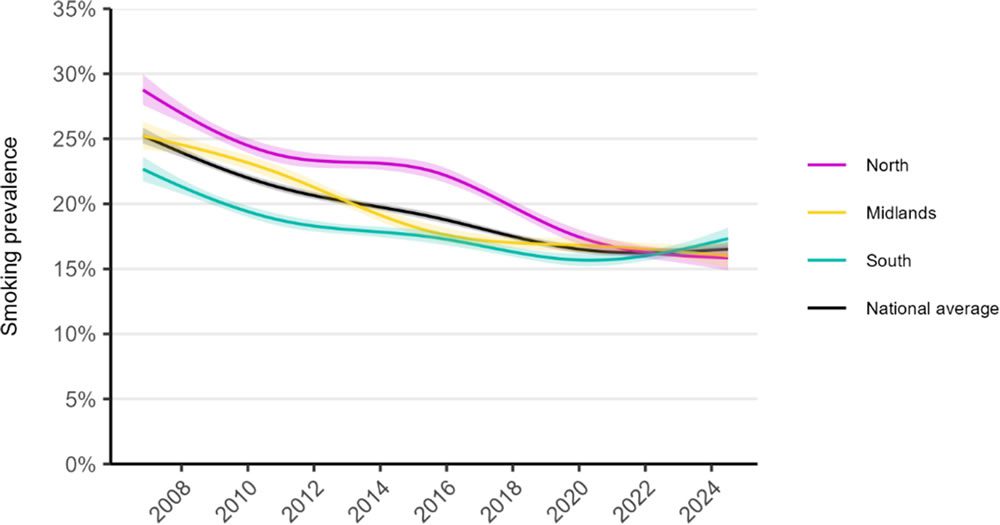For the first time in nearly two decades, smoking rates in certain regions of England have increased, according to a recent study conducted by academics at University College London. The research, which examined smoking data for more than 350,000 adults in England over an 18-year period, found that while the overall proportion of adults who smoke cigarettes, pipes, cigars, or other forms of tobacco fell from 25.3% of the population in 2006 to 16.5% in 2024, progress since 2020 has stagnated, and in some areas, smoking rates are on the rise once again.
The study, published in the journal Addiction, revealed a 10% increase in smoking rates in southern England between 2020 and 2024, in contrast to a 9.7% decrease over the same period in the north. The south-west region experienced the most significant jump in smoking rates, rising by 17% to a figure of 18.7% between 2020 and 2024, while rates in the south-east and London rose by 9% and 8%, respectively.
Extrapolating these figures to the entire population suggests that an estimated 7.5 million adults in England currently smoke, with 3.3 million adults smoking in London, the south-east, and south-west – nearly 400,000 more than in 2020. In contrast, there are 2 million smokers in the north of England – 160,000 fewer than in 2020.
Over the 18 years leading up to 2024, smoking rates in the north have almost halved, dropping from 28.8% to 15.8%, and are now lower than smoking rates in the south. Lead author Dr. Sarah Jackson, of the UCL Institute of Epidemiology and Health Care, attributed this progress to the concentration of dedicated tobacco control programs in northern regions.

However, some experts are concerned that 50% cuts to integrated commissioning boards (ICBs), which fund services such as inpatient tobacco treatment, could jeopardize further progress. Hazel Cheeseman, the chief executive of Action on Smoking and Health, emphasized the importance of sustained investment in smoking cessation programs, warning that if funding is cut, the country risks going backwards and failing to deliver on the vision of a smoke-free nation.
Dr. Ian Walker, executive director of policy and information at Cancer Research UK, which funded the study, stressed the importance of maintaining momentum in the fight against smoking, stating that budget pressures and changes to NHS England cannot compromise funding for programs that help people quit.
The Department of Health and Social Care has reaffirmed its commitment to creating the first smoke-free generation and supporting current smokers in their efforts to quit. The government is investing an additional £70 million for local stop smoking services this year and working to ensure that all NHS hospitals offer 'opt-out' smoking cessation services.
Prof. Kamila Hawthorne, chair of the Royal College of General Practitioners, praised the overall decline in smoking rates across England and the narrowing of regional differences, but expressed concern about the stagnation and rise in smoking rates in some areas. She emphasized the crucial role that GPs and their teams have played in encouraging millions of people to quit smoking and live healthier lives as non-smokers.
As the fight against smoking continues, it is essential that funding for smoking cessation programs remains a top priority and that these services are made easily and equally available across the country. By doing so, England can continue to make progress towards a smoke-free future and improve the health and well-being of its citizens.








